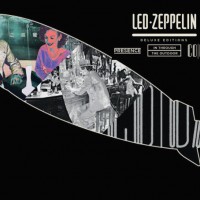Released on March 28, 1973 in the shadow of an acknowledged classic in IV, Led Zeppelin’s Houses of the Holy found the band experimenting with an entirely new palette of sounds.
“Over the Hills and Far Away” became a staple of FM radio, while “D’yer Mak’er” went into the Top 20. Houses would be Zeppelin’s third No. 1 album and was eventually certified 11-times platinum. It was ranked No. 149 on Rolling Stone magazine’s 300 list of the greatest albums ever.
All, amazing feats. But even there, however, Houses of the Holy couldn’t match its 1971 predecessor, which sold 23 million copies – and was ranked 69th by the RS editors.
Decades later, Led Zeppelin’s Houses of the Holy still draws visceral responses from our panel – including S. Victor Aaron, Jimmy Nelson, Fred Phillips, JC Mosquito and Mark Saleski. Is it a forgotten gem? A weird overreach? Something in between? Time to give this 1973 album a second thought …
ALBUM OVERVIEW
S. VICTOR AARON: IV was the album that raised Led Zeppelin to a lofty status among the elite bands in rock history, but those gains were consolidated on Houses of the Holy. Their days as a heavy blues band now well behind them, they nonetheless refused to abandon the blues and instead just incorporated more and more styles into it. English folk, heavy metal, R&B, and exotic sounds from Kingston to Khartoum. On Houses, the R&B element got played up more than on Zoso, the band further refining their mastery of integrating increasingly mystical lyrics, alluring melodies and John Bonham’s galvanic rhythms. Like its predecessor, there’s nothing remotely sounding like filler here – and though there’s also nothing matching the anthemic quality of “Stairway to Heaven,” there were enough songs that got close enough to it to make Houses the equal to its predecessor.
JC MOSQUITO: An album I seriously had to re-think after I became an adult. I was in Grade 8 when I first heard it, and at the time I felt it was such a ridiculous release, particularly since it was the follow up to the all-mighty Led Zeppelin IV. I tried to like it for a few months, then traded it off to a friend for a Lynyrd Skynyrd album, if memory recalls. I didn’t get back to it until Physical Graffiti, a couple of years later. PG was a huge two-record set made up of new recordings and some dust offs from previous albums – including Houses of the Holy. But it gave me a chance to figure out the connections between IV, Houses, and PG. Turned out that the songs “Houses of the Holy,” “The Rover,” and “Black Country Woman” were also part of the original Houses of the Holy sessions. So, yes, I do like it now, but at the time, if asked, my younger self would likely have reviewed it this way.
JIMMY NELSON: If anything, I’ve had that kind of reevaluation about IV, which – likely because it’s been so oversampled on backwards-walking classic rock stations – had lost much of its charm for me. Houses, on the other hand, still sounds fresh, like a band at the peak of its powers willing to experiment in ways that so few were then, or are now. This is their White Album, in the sense that they try on every different hat in their wardrobe. As with the earlier Beatles album, some will come away feeling like the album is nothing more than an unfocused pastiche, others a fizzy moment of discovery. I’m definitely in the latter category.
And now, our thoughts on the songs …
THE SONG REMAINS THE SAME
S. VICTOR AARON: The album literally races out the gate, galloping with a buoyant theme that dives right into one of Page’s trademark blues expressions (so good, he does it again a couple more times) before the song catches its breath to make way for Robert Plant.
JIMMY NELSON: This being Led Zeppelin, you must start with a rampaging opening number – all squiggly guitar lines and stamping bass, topped with another mystical dreamscape narrative courtesy of a still-squeaking Plant. For all of its surface power, this may be the album’s most uninteresting track though, if only because it doesn’t begin to hint at the dizzying complexity to come.
JC MOSQUITO: I never liked the thin, squeaky, effect-drenched vocal performance that is practically the antithesis of anything at all from Led Zeppelin IV. A few years later, I realized it was at least better than any of the vocals on the soundtrack of The Song Remains the Same.
THE RAIN SONG
JC MOSQUITO: Strike Two – a ballad? That’s no way to recover after your lead-off song tanks.
JIMMY NELSON: Funny. For me, this is a tour de force moment for a band I’ve come to think of as the Beatles of heavy music. Certainly, this album shows how they completely embraced that kind of eclecticism – with “The Rain Song,” as much as any other, encapsulating their newfound prowess across an ever-widening musical landscape. (They even seem to reference George Harrison’s “Something” in the early going. Or is that just me?) I love its melancholy Celty folk-inspired entrance, those ever-so-delicate orchestral interludes, the dashing bombast that finds Plant yelping with unbridled delight over a surging Page riff: “But I know that I love you so!” And the way “The Rain Song” settles back into something that combines all of those disparate atmospheres as it comes to a sweetly conveyed conclusion. This song told me: There was nothing this band couldn’t do.
S. VICTOR AARON: One of most heart-wrenching melodies heard on a hard rock record. I love that chord bending down into another one, signifying weeping. The song moves through moods like acts in a play, and John Paul Jones’ piano and the added strings add another layer of sophistication no one knew they had just a couple of years earlier.
OVER THE HILLS AND FAR AWAY
S. VICTOR AARON: Another episodic song, half acoustic folk and half electric metal with Plant’s pliable voice adapting to both sides. Page turns in another memorable solo in the instrumental break.
JIMMY NELSON: Like “Ramble On,” in that it features these whooshing transitions from furious folk strumming to Plant screeching over a crunchy riff, but better constructed: This may be Led Zeppelin’s most addictive hook. And that’s the difference here. Since around the time of III, the band had shown a penchant for moving from heavy blues to celestial roots music. Suddenly now, they could go deeper into a groove. How much deeper? Stay tuned.
JC MOSQUITO: Wow, are they really going to play a ballad after a ballad? Saved by the electric guitar rally at the second verse.
FRED PHILLIPS: I tend to agree with your younger self, JC. I like “Over the Hills and Far Away” and “No Quarter,” but the rest of it? Meh. I wouldn’t care if I never heard “D’yer Ma’ker” again. Of course, I feel the same way about “Kashmir.”
JC MOSQUITO: You doubt “Kashmir”? The definitive Zeppelin gem amongst gems? Good call: “Kashmir” – dull as toast.
THE CRUNGE
S. VICTOR AARON: Funky, funky funky. Just toss in a horn chart and a confounded bridge and it would be a James Brown classic.
JC MOSQUITO: A James Brown parody or a poor scouse imitation – didn’t matter – I didn’t really know what a James Brown or a scouse was anyway.
JIMMY NELSON: Essential? No. Fun as hell: You bet.
DANCING DAYS
JC MOSQUITO: Side Two’s opening track is as wimpy as the opener on Side One.
S. VICTOR AARON: Slightly dissonant theme contrasts with a more straightforward melody held together by Bonham’s signature rock strut. But: “I saw a lion he was standing alone with a tadpole in a jar”?
JIMMY NELSON: I try not to like this song, tell myself that it’s the weakest thing here. But then, they draw me in. What was I saying about addictive hooks before? Screw “Over the Hills and Far Away.” Is it too late to change my vote?
D’YER MAK’ER
JIMMY NELSON: See earlier comments on “The Crunge.” Who knew these guys had a sense of humor?
JC MOSQUITO: If this is reggae, Bob Marley’s ghost is rolling in his grave.
S. VICTOR AARON: Not really reggae, but who cares? The island beat, Bonham style, is a joy.
NO QUARTER
JC MOSQUITO: Now, here’s a Lord of the Rings/Viking death ballad. Very cool.
S. VICTOR AARON: Psychedelia brought into the early ’70s by Jones’ acid-drenched synthesizer and Plant’s processed vocal. Don’t overlook Page’s brief but tasty jazzy guitar turn.
MARK SALESKI: Zeppelin was so great at building a sense of foreboding. I mean, contrast the spooky keyboards that foreshadowed Plant’s vocals, or the freakish squeal of the theremin, or the guitar chords that rumbled along during the chorus — with the Goofball Foreboding™ to be found in say, Marilyn Manson’s contact lens silliness, or Glenn Danzig’s (supposedly) moody scowl. The tension that builds during “No Quarter” always made me a little uneasy, because it was organic, honest, and kind of relentless.
JIMMY NELSON: Spooky weird, almost proggy. Another, whole new side to a band that four albums in, most people thought that they had completely figured out – in particular, well, me. Does this kind of diversity make Houses of the Holy a great album? Not if you were looking for more of the sludgy, sometimes blandly derivative grind of their initial efforts. Though quite frankly I wasn’t, you still couldn’t have convinced me in a million years that a band which started out blatantly ripping off Howlin’ Wolf, Willie Dixon and Sonny Boy Williamson II would, this quickly, mature into such a deeply involving voice in rock. Intoxicatingly mysterious, and – as much as the James Brown, the reggae, the rest – just stunning.
THE OCEAN
MARK SALESKI: One of the reasons that Led Zeppelin was such a powerful band was that they loved to play with dynamics. With “The Ocean,” it was rhythmic dynamics. The main riff of the song snaps back and forth between 7/8 and 4, giving it a lurching quality that adds a sense of forward motion. It kind of reminds me of “Black Dog” in that way, as that song had Page floating those guitar lines over Bonham’s groove, which moved along at half speed. With Plant’s layered vocal break, volume dynamics took over … with that softer section enhancing the nasty crunch of the guitar that would soon follow. Really great stuff.
S. VICTOR AARON: Blues-rock meets heavy funk meets … doo-wop? Zeppelin makes it all sound right.
JC MOSQUITO: OK – finally, a rock ‘n’ roll song. Sorry. Too little, too late. In retrospect, it doesn’t surprise me that the critics dismissed it as self serving and narcissistic. Nobody in my neighborhood liked it much either.
JIMMY NELSON: There could be no better ending to this album of experiments, left turns and goofs. With its stutteringly propulsive grind, this has the immediate feel of classic Led Zeppelin – made all the more powerful because of the imaginatively offbeat things that came before. But even here, there’s a final wackadoo gift when the music completely drops out for something that sounds like, what? A street-corner greaseball vocal interlude? “Sure is fine,” Plant adds when the song cranks back up again. “Blows my mind.” Well, yeah.




